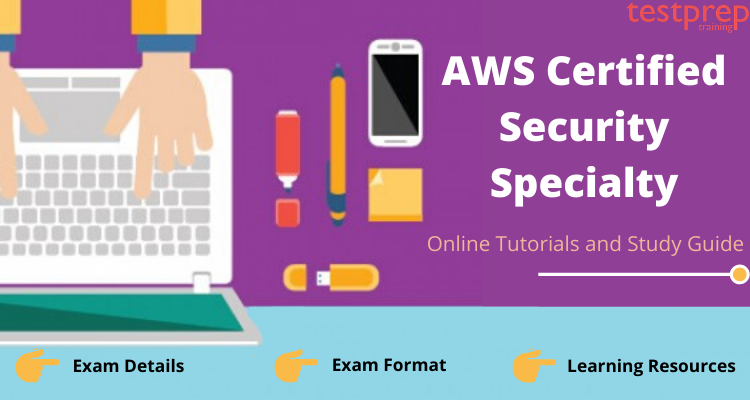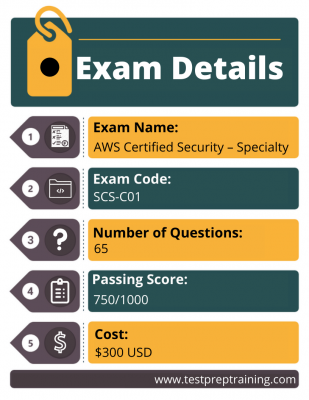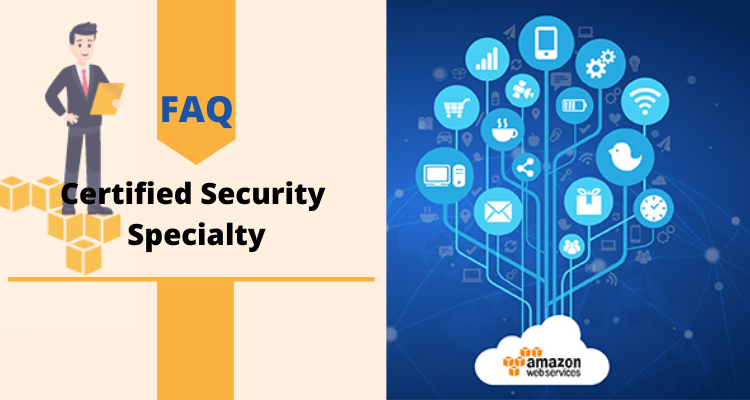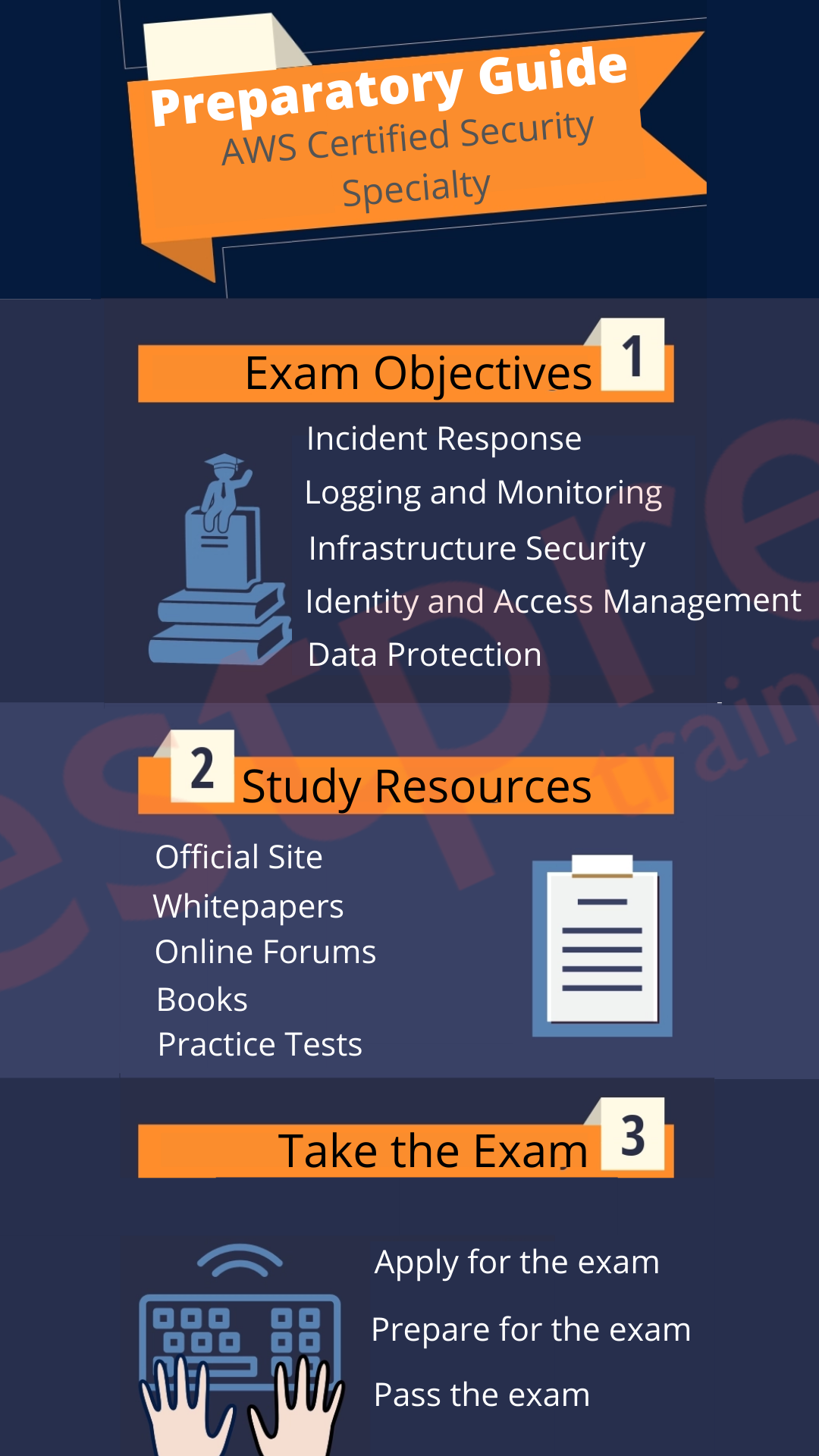AWS Certified Security Specialty

Are you wondering on how to pass AWS Certified Security – Specialty exam ? Then you are in luck today as we present to you the Tutorial that will cater to all your needs for the exam. The AWS Certified Security – Specialty certification helps you gain competitive advantage and broadens your knowledge horizon. Moreover, it increases you earning potential as the AWS Certified Security Specialty salary is US$78k annually.
AWS Certified Security Specialty certification helps cloud security professionals to advance their knowledge on designing and implementing security solutions to secure the AWS platform. The candidates are required to have an understanding of specialized data classifications and AWS data protection mechanisms. Also, candidates must have an understanding of data-encryption methods and AWS mechanisms to implement them together with a working knowledge of AWS security services and features of services to provide a secure production environment.
Who should take the exam?
AWS certified security – specialty (SCS-C01) examination is intended for individuals who perform a security role. AWS exam validates an examinee’s ability to effectively demonstrate knowledge about securing the AWS platform. There are a few aws certified security specialty prerequisites which include candidates are required to have a minimum of five years of IT security experience, designing and implementing security solutions. Also, at least two years of hands-on experience securing AWS workloads with security controls for workloads on AWS.
Exam Format: AWS Certified Security Specialty
The AWS Certified Security Specialty SCS C01 exam consists of 65 questions which will have to be answered in a time frame of 170 minutes. The certification is valid for a period of 3 years and is available in English, Japanese, Korean, and Simplified Chinese. There are two types of questions asked on the examination:
- Multiple choice: Has one correct response and three incorrect responses (distractors).
- Multiple responses: Has two or more correct responses out of five or more options.
Additionally, the AWS certified security specialty certification cost is $300 USD, however, the price may vary from place to place.

How to take the exam?
To register for an exam, the candidate needs to sign in to aws.training and click “Certification” in the top navigation. Next, click “AWS Certification Account” followed by the “Schedule New Exam.
Check: AWS Security Specialty Interview Questions
Course Outline| AWS Certified Security Specialty
The Course Outline acts as the AWS certified security specialty exam blueprint. It provides descriptive details about the exam concepts. You should tailor your study plan around the exam concepts.
The AWS Certified Security Specialty course covers the following domains:
Domain 1: Threat Detection and Incident Response
Task Statement 1.1: Design and implement an incident response plan.
Knowledge of:
- AWS best practices for incident response
- Cloud incidents
- Roles and responsibilities in the incident response plan
- AWS Security Finding Format (ASFF)
Skills in:
- Implementing credential invalidation and rotation strategies in response to compromises (for example, by using AWS Identity and Access Management [IAM] and AWS Secrets Manager)
- Isolating AWS resources
- Designing and implementing playbooks and runbooks for responses to security incidents
- Deploying security services (for example, AWS Security Hub, Amazon Macie, Amazon GuardDuty, Amazon Inspector, AWS Config, Amazon Detective, AWS Identity and Access Management Access Analyzer)
- Configuring integrations with native AWS services and third-party services (for example, by using Amazon EventBridge and the ASFF)
Task Statement 1.2: Detect security threats and anomalies by using AWS services.
Knowledge of:
- AWS managed security services that detect threats
- Anomaly and correlation techniques to join data across services
- Visualizations to identify anomalies
- Strategies to centralize security findings
Skills in:
- Evaluating findings from security services (for example, GuardDuty, Security Hub, Macie, AWS Config, IAM Access Analyzer)
- Searching and correlating security threats across AWS services (for example, by using Detective)
- Performing queries to validate security events (for example, by using Amazon Athena)
- Creating metric filters and dashboards to detect anomalous activity (for example, by using Amazon CloudWatch)
Task Statement 1.3: Respond to compromised resources and workloads.
Knowledge of:
- AWS Security Incident Response Guide
- Resource isolation mechanisms
- Techniques for root cause analysis
- Data capture mechanisms
- Log analysis for event validation
Skills in:
- Automating remediation by using AWS services (for example, AWS Lambda, AWS Step Functions, EventBridge, AWS Systems Manager runbooks, Security Hub, AWS Config)
- Responding to compromised resources (for example, by isolating Amazon EC2 instances)
- Investigating and analyzing to conduct root cause analysis (for example, by using Detective)
- Capturing relevant forensics data from a compromised resource (for example, Amazon Elastic Block Store [Amazon EBS] volume snapshots, memory dump)
- Querying logs in Amazon S3 for contextual information related to security events (for example, by using Athena)
- Protecting and preserving forensic artifacts (for example, by using S3 Object Lock, isolated forensic accounts, S3 Lifecycle, and S3 replication)
- Preparing services for incidents and recovering services after incidents
Domain 2: Security Logging and Monitoring
Task Statement 2.1: Design and implement monitoring and alerting to address security events.
Knowledge of:
- AWS services that monitor events and provide alarms (for example, CloudWatch, EventBridge)
- AWS services that automate alerting (for example, Lambda, Amazon Simple Notification Service [Amazon SNS], Security Hub)
- Tools that monitor metrics and baselines (for example, GuardDuty, Systems Manager)
Skills in:
- Analyzing architectures to identify monitoring requirements and sources of data for security monitoring
- Analyzing environments and workloads to determine monitoring requirements
- Designing environment monitoring and workload monitoring based on business and security requirements
- Setting up automated tools and scripts to perform regular audits (for example, by creating custom insights in Security Hub)
- Defining the metrics and thresholds that generate alerts
Task Statement 2.2: Troubleshoot security monitoring and alerting.
Knowledge of:
- Configuration of monitoring services (for example, Security Hub)
- Relevant data that indicates security events
Skills in:
- Analyzing the service functionality, permissions, and configuration of resources after an event that did not provide visibility or alerting
- Analyzing and remediating the configuration of a custom application that is not reporting its statistics
- Evaluating logging and monitoring services for alignment with security requirements
Task Statement 2.3: Design and implement a logging solution.
Knowledge of:
- AWS services and features that provide logging capabilities (for example, VPC Flow Logs, DNS logs, AWS CloudTrail, Amazon CloudWatch Logs)
- Attributes of logging capabilities (for example, log levels, type, verbosity)
- Log destinations and lifecycle management (for example, retention period)
Skills in:
- Configuring logging for services and applications
- Identifying logging requirements and sources for log ingestion
- Implementing log storage and lifecycle management according to AWS best practices and organizational requirements
Task Statement 2.4: Troubleshoot logging solutions.
Knowledge of:
- Capabilities and use cases of AWS services that provide data sources (for example, log level, type, verbosity, cadence, timeliness, immutability)
- AWS services and features that provide logging capabilities (for example, VPC Flow Logs, DNS logs, CloudTrail, CloudWatch Logs)
- Access permissions that are necessary for logging
Skills in:
- Identifying misconfiguration and determining remediation steps for absent access permissions that are necessary for logging (for example, by managing read/write permissions, S3 bucket permissions, public access, and integrity)
- Determining the cause of missing logs and performing remediation steps
Task Statement 2.5: Design a log analysis solution.
Knowledge of:
- Services and tools to analyze captured logs (for example, Athena, CloudWatch Logs filter)
- Log analysis features of AWS services (for example, CloudWatch Logs Insights, CloudTrail Insights, Security Hub insights)
- Log format and components (for example, CloudTrail logs)
Skills in:
- Identifying patterns in logs to indicate anomalies and known threats
- Normalizing, parsing, and correlating logs
Domain 3: Infrastructure Security
Task Statement 3.1: Design and implement security controls for edge services.
Knowledge of:
- Security features on edge services (for example, AWS WAF, load balancers,
Amazon Route 53, Amazon CloudFront, AWS Shield) - Common attacks, threats, and exploits (for example, Open Web Application
Security Project [OWASP] Top 10, DDoS) - Layered web application architecture
Skills in:
- Defining edge security strategies for common use cases (for example, public website, serverless app, mobile app backend)
- Selecting appropriate edge services based on anticipated threats and attacks (for example, OWASP Top 10, DDoS)
- Selecting appropriate protections based on anticipated vulnerabilities and risks (for example, vulnerable software, applications, libraries)
- Defining layers of defense by combining edge security services (for example, CloudFront with AWS WAF and load balancers)
- Applying restrictions at the edge based on various criteria (for example, geography, geolocation, rate limit)
- Activating logs, metrics, and monitoring around edge services to indicate attacks
Task Statement 3.2: Design and implement network security controls.
Knowledge of:
- VPC security mechanisms (for example, security groups, network ACLs, AWS Network Firewall)
- Inter-VPC connectivity (for example, AWS Transit Gateway, VPC endpoints)
- Security telemetry sources (for example, Traffic Mirroring, VPC Flow Logs)
- VPN technology, terminology, and usage
- On-premises connectivity options (for example, AWS VPN, AWS Direct Connect)
Skills in:
- Implementing network segmentation based on security requirements (for example, public subnets, private subnets, sensitive VPCs, on-premises connectivity)
- Designing network controls to permit or prevent network traffic as required (for example, by using security groups, network ACLs, and Network Firewall)
- Designing network flows to keep data off the public internet (for example, by using Transit Gateway, VPC endpoints, and Lambda in VPCs)
- Determining which telemetry sources to monitor based on network design, threats, and attacks (for example, load balancer logs, VPC Flow Logs, Traffic Mirroring)
- Determining redundancy and security workload requirements for communication between on-premises environments and the AWS Cloud (for example, by using AWS VPN, AWS VPN over Direct Connect, and MACsec)
- Identifying and removing unnecessary network access
- Managing network configurations as requirements change (for example, by using AWS Firewall Manager)
Task Statement 3.3: Design and implement security controls for compute workloads.
Knowledge of:
- Provisioning and maintenance of EC2 instances (for example, patching, inspecting, creation of snapshots and AMIs, use of EC2 Image Builder)
- IAM instance roles and IAM service roles
- Services that scan for vulnerabilities in compute workloads (for example, Amazon Inspector, Amazon Elastic Container Registry [Amazon ECR])
- Host-based security (for example, firewalls, hardening)
Skills in:
- Creating hardened EC2 AMIs
- Applying instance roles and service roles as appropriate to authorize compute workloads
- Scanning EC2 instances and container images for known vulnerabilities
- Applying patches across a fleet of EC2 instances or container images
- Activating host-based security mechanisms (for example, host-based firewalls)
- Analyzing Amazon Inspector findings and determining appropriate mitigation techniques
- Passing secrets and credentials securely to compute workloads
Task Statement 3.4: Troubleshoot network security.
Knowledge of:
- How to analyze reachability (for example, by using VPC Reachability Analyzer and Amazon Inspector)
- Fundamental TCP/IP networking concepts (for example, UDP compared with TCP, ports, Open Systems Interconnection [OSI] model, network operating system utilities)
- How to read relevant log sources (for example, Route 53 logs, AWS WAF logs, VPC Flow Logs)
Skills in:
- Identifying, interpreting, and prioritizing problems in network connectivity (for example, by using Amazon Inspector Network Reachability)
- Determining solutions to produce desired network behavior
- Analyzing log sources to identify problems
- Capturing traffic samples for problem analysis (for example, by using Traffic Mirroring)
Domain 4: Identity and Access Management
Task Statement 4.1: Design, implement, and troubleshoot authentication for AWS resources.
Knowledge of:
- Methods and services for creating and managing identities (for example, federation, identity providers, AWS IAM Identity Center [AWS Single Sign-On], Amazon Cognito)
- Long-term and temporary credentialing mechanisms
- How to troubleshoot authentication issues (for example, by using CloudTrail, IAM Access Advisor, and IAM policy simulator)
Skills in:
- Establishing identity through an authentication system, based on requirements
- Setting up multi-factor authentication (MFA)
- Determining when to use AWS Security Token Service (AWS STS) to issue temporary credentials
Task Statement 4.2: Design, implement, and troubleshoot authorization for AWS resources.
Knowledge of:
- Different IAM policies (for example, managed policies, inline policies, identity-based policies, resource-based policies, session control policies)
- Components and impact of a policy (for example, Principal, Action, Resource, Condition)
- How to troubleshoot authorization issues (for example, by using CloudTrail, IAM Access Advisor, and IAM policy simulator)
Skills in:
- Constructing attribute-based access control (ABAC) and role-based access control (RBAC) strategies
- Evaluating IAM policy types for given requirements and workloads
- Interpreting an IAM policy’s effect on environments and workloads
- Applying the principle of least privilege across an environment
- Enforcing proper separation of duties
- Analyzing access or authorization errors to determine cause or effect
- Investigating unintended permissions, authorization, or privileges granted to a resource, service, or entity
Domain 5: Data Protection
Task Statement 5.1: Design and implement controls that provide confidentiality and integrity for data in transit.
Knowledge of:
- TLS concepts
- VPN concepts (for example, IPsec)
- Secure remote access methods (for example, SSH, RDP over Systems Manager Session Manager)
- Systems Manager Session Manager concepts
- How TLS certificates work with various network services and resources (for example, CloudFront, load balancers)
Skills in:
- Designing secure connectivity between AWS and on-premises networks (for example, by using Direct Connect and VPN gateways)
- Designing mechanisms to require encryption when connecting to resources (for example, Amazon RDS, Amazon Redshift, CloudFront, Amazon S3, Amazon DynamoDB, load balancers, Amazon Elastic File System [Amazon EFS], Amazon API Gateway)
- Requiring TLS for AWS API calls (for example, with Amazon S3)
- Designing mechanisms to forward traffic over secure connections (for example, by using Systems Manager and EC2 Instance Connect)
- Designing cross-Region networking by using private VIFs and public VIFs
Task Statement 5.2: Design and implement controls that provide confidentiality and integrity for data at rest.
Knowledge of:
- Encryption technique selection (for example, client-side, server-side, symmetric, asymmetric)
- Integrity-checking techniques (for example, hashing algorithms, digital signatures)
- Resource policies (for example, for DynamoDB, Amazon S3, and AWS Key Management Service [AWS KMS])
- IAM roles and policies
Skills in:
- Designing resource policies to restrict access to authorized users (for example, S3 bucket policies, DynamoDB policies)
- Designing mechanisms to prevent unauthorized public access (for example, S3 Block Public Access, prevention of public snapshots and public AMIs)
- Configuring services to activate encryption of data at rest (for example, Amazon S3, Amazon RDS, DynamoDB, Amazon Simple Queue Service [Amazon SQS], Amazon EBS, Amazon EFS)
- Designing mechanisms to protect data integrity by preventing modifications (for example, by using S3 Object Lock, KMS key policies, S3 Glacier Vault Lock, and AWS Backup Vault Lock)
- Designing encryption at rest by using AWS CloudHSM for relationaldatabases (for example, Amazon RDS, RDS Custom, databases on EC2 instances)
- Choosing encryption techniques based on business requirements
Task Statement 5.3: Design and implement controls to manage the lifecycle of data at rest.
Knowledge of:
- Lifecycle policies
- Data retention standards
Skills in:
- Designing S3 Lifecycle mechanisms to retain data for required retention periods (for example, S3 Object Lock, S3 Glacier Vault Lock, S3 Lifecycle policy)
- Designing automatic lifecycle management for AWS services and resources (for example, Amazon S3, EBS volume snapshots, RDS volume snapshots, AMIs, container images, CloudWatch log groups, Amazon Data Lifecycle Manager)
- Establishing schedules and retention for AWS Backup across AWS services
Task Statement 5.4: Design and implement controls to protect credentials, secrets, and cryptographic key materials.
Knowledge of:
- Secrets Manager
- Systems Manager Parameter Store
- Usage and management of symmetric keys and asymmetric keys (for example, AWS KMS)
Skills in:
- Designing management and rotation of secrets for workloads (for example, database access credentials, API keys, IAM access keys, AWS KMS customer managed keys)
- Designing KMS key policies to limit key usage to authorized users
- Establishing mechanisms to import and remove customer-provided key material
Domain 6: Management and Security Governance
Task Statement 6.1: Develop a strategy to centrally deploy and manage AWS accounts.
Knowledge of:
- Multi-account strategies
- Managed services that allow delegated administration
- Policy-defined guardrails
- Root account best practices
- Cross-account roles
Skills in:
- Deploying and configuring AWS Organizations
- Determining when and how to deploy AWS Control Tower (for example,
which services must be deactivated for successful deployment) - Implementing SCPs as a technical solution to enforce a policy (for example,
limitations on the use of a root account, implementation of controls in AWS
Control Tower) - Centrally managing security services and aggregating findings (for example,
by using delegated administration and AWS Config aggregators) - Securing AWS account root user credentials
Task Statement 6.2: Implement a secure and consistent deployment strategy for cloud resources.
Knowledge of:
- Deployment best practices with infrastructure as code (IaC) (for example,
AWS CloudFormation template hardening and drift detection) - Best practices for tagging
- Centralized management, deployment, and versioning of AWS services
- Visibility and control over AWS infrastructure
Skills in:
- Using CloudFormation to deploy cloud resources consistently and securely
- Implementing and enforcing multi-account tagging strategies
- Configuring and deploying portfolios of approved AWS services (for example, by using AWS Service Catalog)
- Organizing AWS resources into different groups for management
- Deploying Firewall Manager to enforce policies
- Securely sharing resources across AWS accounts (for example, by using AWS Resource Access Manager [AWS RAM])
Task Statement 6.3: Evaluate the compliance of AWS resources.
Knowledge of:
- Data classification by using AWS services
- How to assess, audit, and evaluate the configurations of AWS resources (for example, by using AWS Config)
Skills in:
- Identifying sensitive data by using Macie
- Creating AWS Config rules for detection of noncompliant AWS resources
- Collecting and organizing evidence by using Security Hub and AWS Audit Manager
Task Statement 6.4: Identify security gaps through architectural reviews and cost analysis.
Knowledge of:
- AWS cost and usage for anomaly identification
- Strategies to reduce attack surfaces
- AWS Well-Architected Framework
Skills in:
- Identifying anomalies based on resource utilization and trends
- Identifying unused resources by using AWS services and tools (for example, AWS Trusted Advisor, AWS Cost Explorer)
- Using the AWS Well-Architected Tool to identify security gaps
Exam Policies
Amazon Web Services (AWS) is one of the most dominant and successful players in the field of cloud computing. Being a game-changer and a responsible vendor, AWS provides exam policies for potential candidates in a comprehensive yet succinct way to help them derive positive outcomes. This exam policies include general information, training, and certification details that are required before and after the exam.

For More Queries Visit : AWS Certified Security Specialty FAQs
AWS Learning Resources
Security Basics
Incidence Response
Logging and Monitoring
- CloudWatch Basics
- CloudWatch Dashboard
- S3 Logs
- CloudWatch Metrics
- CloudWatch Alarms
- AWS Config
- CloudWatch Logs
- CloudTrail Basics
- CloudTrail Events
Edge Security
Network Security
AWS and Host Security
IAM and Security Policies
- Compliance On AWS
- Shared Responsibility
- AWS IAM
- IAM Roles and Policies
- Identity Federation
- MFA
- Security Token Service
Data Protection
Preparatory Guide for AWS Certified Security Specialty
We will be providing the learning resources to get the most from your efforts in the AWS Certified Security Specialty study guide.

Official Site
Amazon prescribes that before taking the exam you should have enough hands-on experience with relevant AWS products and services. Amazon has its own courses for preparation and sample tests too. Also, one can take AWS Certified Security Specialty training and practice exams in order to test your knowledge in a timed environment. These are also available on the official site. Besides these, AWS offers learning paths with an intent to build your technical skills. The courses made available by amazon are- AWS Security Fundamentals (Second Edition), Architecting on AWS, Security Engineering on AWS. You should also gather all the information about the exam from the official site itself.
Whitepapers
Cadndaiets preparing for the AWS can also take the help of amazon whitepapers for preparation. The AWS certified security specialty whitepapers are authentic study resources which we can surely vouch for. These are basically the pdf formats of the topics which you can find on the official page of amazon certifications. Whitepapers not only strengthen your preparation process but also helps you build a strong strategy to lay your focus on. AWS offers sample papers to assist the candidates with acquiring additional knowledge and skills to prepare for the certification exams.
Online forums
To diversify your study strategy for AWS certified security – specialty certification exam you can join Online Forums. Online study groups and forums help you can ask people who have already given the exam or who are preparing for the same, your doubts. You can even take tests of each other to see the level of preparation. Clearing the doubts will help in boosting self-confidence and will also let you see into your weak parts. The discussion will help to identify the parts where more preparation is needed and parts that are fully prepared.
Books
The AWS certified security specialty book are a perennial source available for learning. There are various books available for the security specialty exam which you can find online or in libraries. Some of the books that can arm you are as follows:
- AWS Certified Security Specialty Workbook: Exam SCS-C01 by IP Specialist
- AWS Certified Advanced Networking Official Study Guide: Specialty Exam by Sidhartha Chauhan
- Mastering AWS Security: Create and maintain a secure cloud ecosystem by Albert Anthony
Practice Tests
Finally, all you need is AWS certified security specialty practice exam. Practice tests are the oldest yet the most essential part of exam preparation. Solve as many sample papers and test series as this will help you to identify the level at which you are and how much preparation do you still need. The Internet is flooded with a plethora of practice tests, so make sure to find the most reliable and authentic one to end your preparation process. practice tests will help you evaluate yourself as well as boost your confidence.
Get ready to Practice and Prepare for AWS Certified Security Specialty Exam


